Fahlman B.D. Materials Chemistry
Подождите немного. Документ загружается.

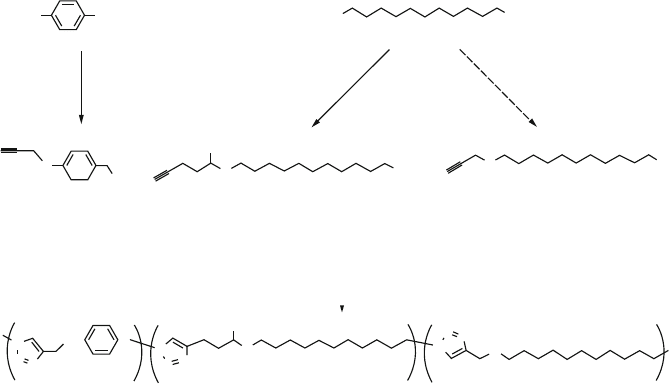
5.3. “SOFT MATERIALS” APPLICA TIONS: STRUCTURE
VS. PROPERTIES
Thus far, we have considered a large number of polymer types, which are used
for a diverse range of applications. In this section, we will now consider more
specific examples of applications, to show how the molecular structure of the
polymer drastically affects its properties. For polymers, only slight changes in
the polymer backbone, or interaction with neighboring polymer chains, will lead
to very different physical properties (and resultant applications). Whereas the
backbone structure affects the polymer’s general flexibility, the intermolecular
interactions between side groups of neighboring polymer chains affect the overall
strength, solubility, crystallinity, and glass-transition temperature (T
g
).
As you might expect, the influence of the nature and density of side groups vs. the
backbone structure will stro ngly depend on the relative composition of each polymer
unit, as well as how open the structure is to its environment. Regarding the relative
composition of a polymer, even though a polymer may have a polar backbone
structure (e.g., ether and/or ester linkages), the structure may not be soluble within
polar solvent s. That is, if long nonpolar side chains are also present in the polymeric
HO
O
O
O
O
O
O
O
N
N
N
5: x = 1
8: x = 1/2, y = 1/2 9: x = 1/2, z = 1/2 10: y = 1/2, z = 1/2 11: x = 1/3, y = 1/3, z = 1/3
6: y = 1 7: z = 1
N
N
N
N
N
N
y
z
x
O
a)
b)
c)
d)
e)
f)
g)
HO
1
2
(Y = 82.0%)
a) propargyl bromide, K
2
CO
3
, acetone ; b) LiAlH
4
, THF ; c) CBr
4
, PPh
3
, THF ; d) NaN
3
, H
2
O ;
e) 4-pentynoic acid, DCC, DPTS, DMAP, CH
2
Cl
2
; f) propargyl bromide, NaH, THF ; g) Cu(PPh
3
)
3
Br, DIPEA, CHCl
3
.
(Y = 83.2%) (Y = 85.9%)
3
+
+
4
N
3
N
3
N
3
N
3
COOMe
Figure 5.37. Click chemistry step growth (co)polymerization of a-azide-o-alkyne monomers 2–4.
Adapted with permission from Binauld, S.; Damiron, D.; Hamaide, T.; Pascault, J. -P.; Fleury, E.;
Drockenmuller, E. Chem. Commun., 2008, 4138. Copyright 2008 Royal Society of Chemistry.
388 5 Polymeric Materials
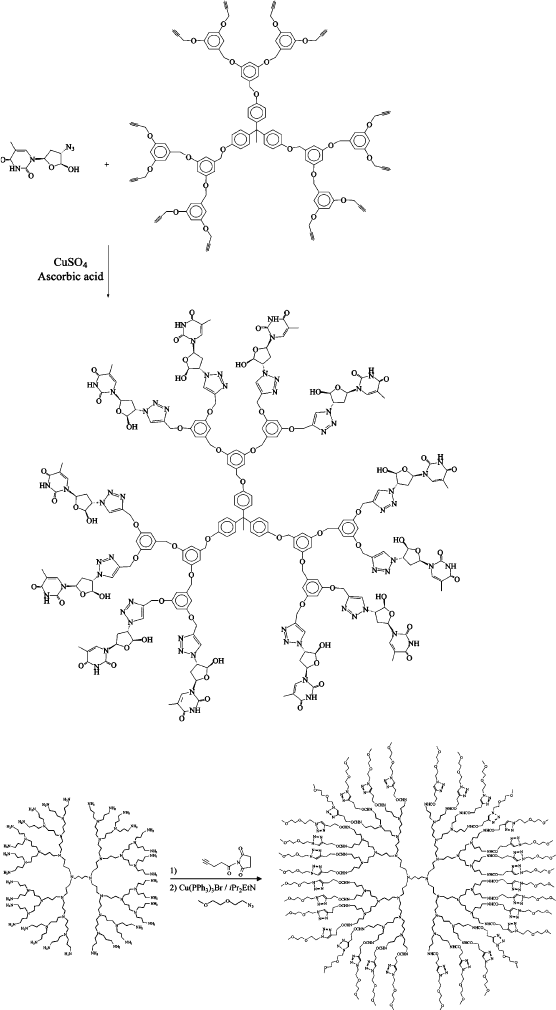
Figure 5.38. Dendrimer synthesis using aqueous click chemistry. Reproduced with permission from
Malkoch, M.; Schleicher, K.; Drockenmuller, E.; Hawker, C. J.; Russell, T. P.; Wu, P.; Fokin, V. V.
Macromolecules, 2005, 38, 3663. Copyright 2005 American Chemical Society.
5.3. “Soft Materials” Applications: Structure vs. Properties 389
structure, its solubility and reactivity will be outweighed by the presence of
hydrocarbon chains. A useful analogy to keep in mind is the pronounced decrease
in water solubility of simple alcohols, from methanol (completely miscible) to
hexanol and higher-hydrocarbon chains (complete immiscibility) as the overall
ratio of non-polar:polar functionality increases.
Regarding the interaction of a polymer with its environment, consider the
PAMAM dendrimers described in the previous section. For higher generations, the
pronounced density of the peripheral functional groups prevents the solvent or other
environmental molecules from interacting with the core groups. As a result, the
solubility/reactivity of these polymers may be fine-tuned by varying the surface
functional groups. As we will see in Chapter 6, the inner-core shielding exhibited by
dendrimers (e.g., G4–G6 for PAMAM or PPI) allows one to encapsulate a number of
species within these “nanocavity reactors” for a number of useful applications for
novel nanomaterials synthesis, catalysis, and drug-delivery.
Table 5.4 lists the various functional groups that may be present in the polymer
backbone and as side-groups, with their general effect on overall properties.
It should be noted that these comparisons are over-simplications; for example, the
presence of crosslinking and/ or combinations of different functionalities will yield
very different polymer properties. As discussed above, the general trend of chemical
inertness and solubility will depend on both the openness of the structure and nature/
density of the side groups . For thermal stability, conductivity, and flexibility, the
polymer backbone structure is most relevant. Changes from sing le to multiple
bonding, and/or introdu ction of a delocalized resonance unit in the polymer chain,
will have pronounced effects on overall p roperties. One factor that is not explicitly
mentioned in Table 5.4 is the degree of branching. However, it should be intuitive
that the greater degree of interaction among adjacent polymer chains will enhance
the tensile strengt h and density of the polymer, as well as increase the T
g
. Perhaps
the best example of this behavior is for highly branched low-density polyethylene
(LDPE; used for squeeze bottles, food packaging film, plastic tubing, etc.) vs.
weakly branched high-density polyethylene (HDPE; used for tupperware, milk
cartons, plastic bags, etc.), as illustrated in Figure 5.39. Whereas the density and
tensile strength for HDPE is 0.941–0.965 g/cm
3
and 43 MPa, LDPE has values of
0.910–0.925 g/cm
3
and 37 MPa, respectively.
The crystallinity of a polymer is related to the packing efficiency of individual
polymer chains with respect to one another. Not unlike the formation of small
molecule single crystals, processing variables such as temperature and time are
paramount for influencing the degree of crystallinity. As previously mentioned,
non-amorphous polymers may be considered as semic rystalline at best, with regions
of crystallinity within the largely d isordered polymer matrix. Typical crystalline
polymers are polypropylene and polyethylene (especially isotac tic and syndiotactic,
Figure 5.40), acetals, nylons, and most thermoplastic polyesters. In general, crystal-
line polymers have high shrinkage, low transparency, a distinct melting point, and
possess good chemical and wear resistance. By contrast, polymers that contain
bulkier side-groups on their chains, such as polystyrene, polycarbonate, acrylic,
390 5 Polymeric Materials

ABS, and polysulfone, tend to form amorphous polymers. Based on their disordered
structure, amorphous polymers have low shrinkage, a transparent appearance, a
broad melting point, and poor chemical and wear resistance.
Silicones
Though most of the backbone units appearing in Table 5.4 are carbonaceous, there
is one major class of polymers that are comprised of crosslinked [O—SiR
2
—]
n
units. These polymers are known as silicones or polyorganosiloxanes – infamously
popular due to the bad press over a decade ago concerning silicone breast implants.
By varying the —Si—O— chain lengths, Si-alkyl groups, and extent of crosslink-
ing, the resultant polymer may exist as a viscous liquid ( e.g., vacuum pump oil), a
gel (e.g., silicone grease), or rubbery material (e.g., used for remote control key-
pads). Figure 5.41 illustrates the diverse use of silicone-based devices within the
body. Their extensive use for biomedical applications is due to their biocompatibil-
ity, sterilizability, surface adhesion, oxygen permeability, and resistance to attack
Table 5.4. Influence of Polymer Structure on Resultant Properties
b
Backbone unit/
s
substituent Induced molecular properties
b
Saturated carbon (—C—C—) Chain flexibility, thermal/oxidative reactivity
b
Unsaturated carbon (—C═C—) Chain rigidity, high T
g
, oxidative reactivity
b
Aromatic (—C—C═C—) Chain rigidity, colors, electrical conductivity (if aromatic rings:
oxidative resistance, high strength, stacking/self-alignment (liquid
crystals
[48]
))
b
Ether (—C—O—C—) Chain flexibility, oxidative/hydrolytic stability (unless in Lewis acidic
media), soluble in polar solvents (for small substituents)
b
Anhydride (—C—C(O)—O—
C(O)—C—)
Chain flexibility, water sensitive (especially for short aliphatic chains)
b
Amide (—NH—C(O)—) Chain rigidity, crystalline, water sensitive
b
Siloxane (—R
2
Si—O—) Chain flexibility and low T
g
(especially for small substituents), stable
toward oxidation, acid/base reactive
b
Phosphazene (—R
2
P═N—) Chain flexibility, high chemical inertness
b
Sulfur (—S—S—) Chain flexibility, thermal/oxidative reactivity
s
Hydrogen (—H) Chain flexibility, low T
g
; if bound to non-C atoms: H-bonding (high
T
g
, m.p., chemical reactivity)
s
Alkyl (—CR
3
) Chain rigidity, hydrophobicity, chemical inertness, noncrystallinity,
solubility in nonpolar solvents (properties dependent on size of
R groups – most pronounced for aryl groups)
s
Halogens (—F,—Cl) Fluoride: extreme chemical inertness, hydrophobicity, insolubility in
virtually any solvent
Chloride: chemical inertness, chain stiffness, photolytic sensitivity,
# solubility, fire retardancy
s
Hydroxyl (—OH) Hydrophilic, H-bonded rigid framework (" T
g
)
s
Cyano (—CN) Hydrophilic, dipole–dipole interactions: " T
g
and crystalline
s
Amide (—C(O)—NH
2
) Hydrophilic, very high T
g
due to strong H-bonding
s
Ester (—C(O)—O—) May be hydrophilic or hydrophobic depending on alkyl substituents,
T
g
also varies with nature of R and tacticity of units
s
Ether (—O—CR
3
) Hydrophilic at low temperatures, solubility and properties vary with
R groups and tacticity
s
Carboxylic acid (—C(O)—OH) Hydrophilic and hygroscopic in solid-state
5.3. “Soft Materials” Applications: Structure vs. Properties 391
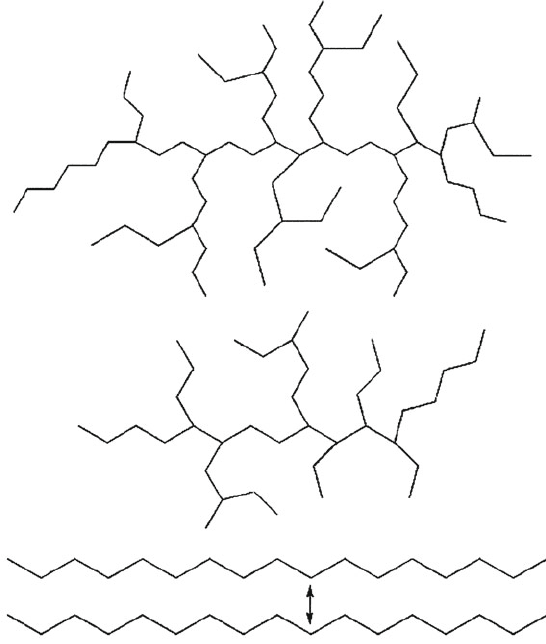
from body defense systems. The most widely used silicones are known as poly-
dimethylsiloxanes (PDMS), formed from the hydrolysis of chlorosilanes in the
presence of water (Eq. 4). In order to increase the polymer size to that require d for
most applications, the linear and cyclic oligomeric units are subsequently condensed
and polymerized, respectively.
[49]
xMe
2
SiCl
2
!
H
2
O
yHOðMe
2
SiOÞ
n
H + z (Me
2
SiOÞ
m
(linear) (cyclic)
ð4Þ
More branching (LDPE)
fewer van der Waal
intermolecular interactions
among neighboring polymers
Less branching (HDPE)
much stronger van der Waal
intermolecular interactions
among neighboring polymers
(adjacent polymers may interact
along their entire chains)
Figure 5.39. Comparison of low-density polyethylene and high-density polyethylene backbone
molecular structures. A higher degree of branching (LDPE) results in greater separation of neighboring
polymer chains and fewer intermolecular interactions. By comparison, with little/no branching, adjacent
chains may closely associate with one another, resulting in strong van der Waal forces along the entire
length of the polymer chains.
392 5 Polymeric Materials
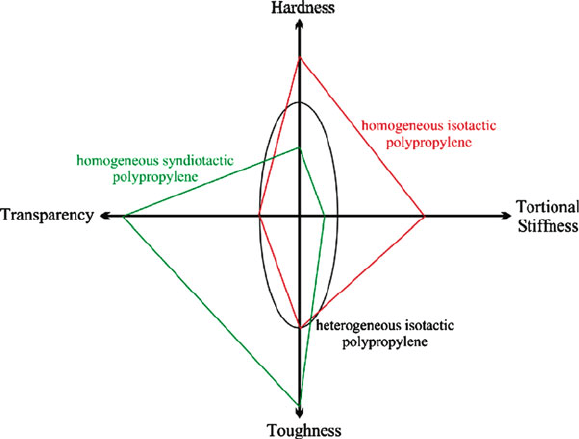
5.3.1. Biomaterials Applications
The world of biomaterials is diverse, encompassing ceramics and metals used for
orthopedic implants (already discussed in Chapters 2 and 3), to artificial heart
valves, blood vessel stents, and contact lenses. This section will d elve into those
biomaterials applications that utilize “soft” polymeric-based materials.
Biodegradable polymers
In our ever-increasingly “green” society, it is becoming hard to justify the use of
traditional synthetic, non-biodegradable polymers for short-lived applications such
as packaging, personal hygiene, surgery, etc. In addition to the persistency of
non-biodegradable polymers in the environment, groundwater/soil pollution is also
possible via additive leaching. Combustion (and even recycling processes) of these
polymers consumes large quantities of energy and may also yield toxic emissions
such as dioxins. Anyone who has seen dramatic images of plastic bottle holders
wrapped around the necks of wildlife should be moved to evaluate viable alter-
natives that will break down more readily in the environment.
By definition, biodegradable materials exhibit chemical structures that will
decompose under aerobic (e.g., composting) and/or anaerobic (e.g., landfill) condi-
tions.
[50]
Typical degradation byproducts are CO
2
,CH
4
,H
2
O, inorganic compounds
(e.g., PO
x
, SiO
x
), or biomass. Whereas degradation refers to the decomposition of a
polymer by chemical means (e.g., hydrolysis), biodegradation is carried out by the
Figure 5.40. Tacticity vs. bulk properties for polypropylene polymers. The “homogeneous” and
“heterogeneous” notations refer to whether the entire polymer chains, or only regions, are of a certain
tacticity.
5.3. “Soft Materials” Applications: Structure vs. Properties 393
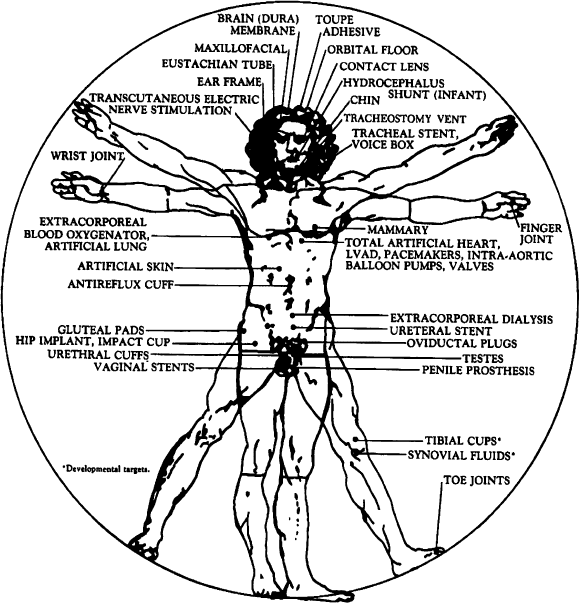
enzymatic activity of microorganisms. In this latter route, the decomposition of the
plastic is afforded by the metabolism by microorganisms that generate an inert
humus-like byproduct that is much less environmentally-harmful/pervasive. The
terms bioabsorption or bioresorption refer to the degra dation byproducts being
used in cellular processes.
[51]
Biodegradable polymers should exhibit the following characteristics:
(i) Biocompatible (e.g., elicits little/no immune response or is able to integrate
with aparticular tissue);
(ii) Tu nable and predictable degradation mechanism and rate;
(iii) Non-toxic degradation products and metabolites;
(iv) Non-toxic additives (e.g., monomers, initiators, emulsifiers, etc.);
(v) Easy to synthesize and process into the desired shape;
(vi) Long shelf-life and facile sterilization
There are two primary classes of biodegradable polymers – either naturally-
occurring or generated using synthetic organic procedures (Figure 5.42).
[52]
There
Figure 5.41. Placement of silicone-based medical devices in the body. Reproduced with permission from
CHEMTECH 1983, 13, 542.
394 5 Polymeric Materials
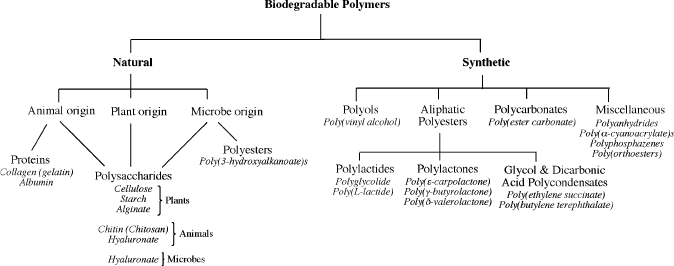
are three origins of natural polymers, from plants, animals, or microbes. Polymers
such as polysaccharides may be formed from all of these sources, whereas natural
polyesters (e.g., poly(3-hydroxyalkanoate)s) are generated exclusively from micro-
bial routes. It should be noted that all natural polyesters are biodegradable; however,
most synthetic varieties such as those used for fabrics, bottles, tarpaulins, canoe s,
LCDs, filters, etc., are not.
The majority of biodegradable polymers are synthesized by a ring-opening
polymerization mechanism (e.g., Figure 5.43).
[53]
One example is the ring-opening
polymerization of lactide to yield poly(lactic acid) (PLA) – one of the most widely
used biodegradable polymers.
[54]
This route features an aluminum or tin
[55]
alkoxide
complex that catalyzes a “coordination insertion” mechanism, which proceeds via
rupture of the acyl-oxygen bond of the monomer (Figure 5.44).
[56]
Monocarboxylic
iron complexes have also been shown to polymerize l-lactide by an anio nic-based
insertion mechanism.
[57]
By definition, either cationic or anionic ring-opening poly-
merization may take place, wherein the reactive center of the propagating chain is a
carbocation or carbanion, respectively. Recently, IBM has developed a family of
organocatalysts such as N-heterocyclic carbenes, bifunctional thiourea-amines, and
“superbases” (e.g., guanidines, amidines) for the controlled polymerization of strained
heterocyclics. As Figure 5.45 illustrates, this new synthetic method is amenable for
the polymerization of lactones (e.g., PLA; poly(vinylalcohol) – PVA, etc.), cyclic
carbonates (e.g., poly(tetramethylene carbonate) – PTMC, etc.), ethers (e.g., poly
(ethylene oxide) – PEO), and silyl ethers (e.g., poly(dimethylsiloxane) – PDMS,
etc.).
[58]
It should be noted that enzymatic routes have also been investigated in recent
years – a truly “green” alternative for polymer synthesis.
[59]
Figures 5.46 and 5.47 illustrate the various oxidative and hydrolytic biodegrada-
tive reactions, respectively, which are responsi ble for polymer degradation. As one
can see, polymers with C(O)X groups such as esters, amides, urethanes, etc. are
particularly hydrolyt ic degradable. In contrast, groups that are stable toward hydro-
lysis (non-biodegradable) include hydrocarbon backbones (e.g., polyethylene,
polypropylene), halocarbon backbones (polytetrafluoroethylene, poly(vinylidene
Figure 5.42. Classification scheme for biodegradable polymers.
5.3. “Soft Materials” Applications: Structure vs. Properties 395
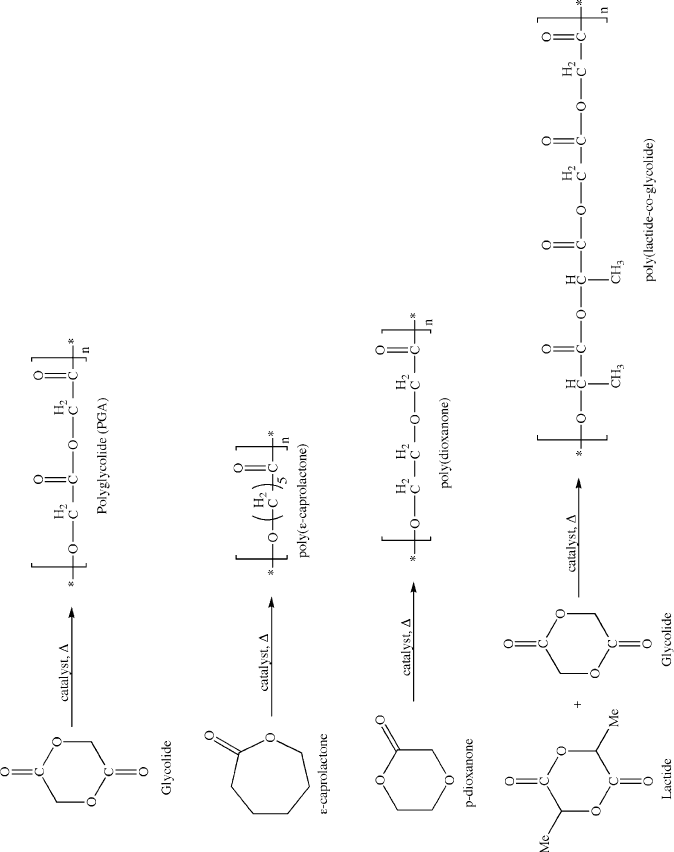
Figure 5.43. Ring-opening polymerization of various biodegradable polymers.
396 5 Polymeric Materials
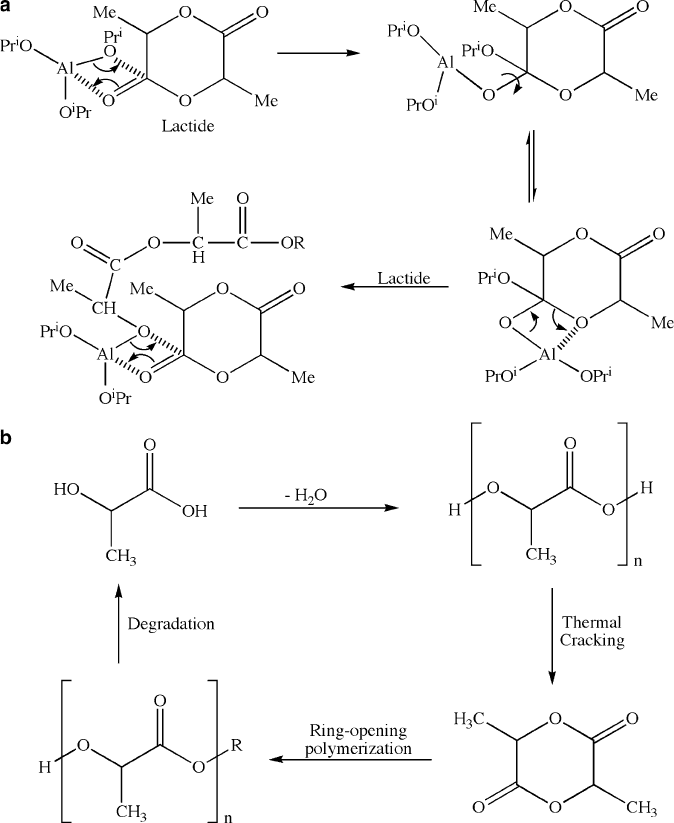
fluoride), polychlorotrifluoroethylene, etc .), alkylsiloxanes (e.g., dimethylsiloxanes,
(R
2S
iO)
x,
etc.), and sulfones ((O)S(O))
x
.
The applications for biodegradable polymers span a variety of fields such as:
–Agriculture(e.g., mulch films, temporary planting pots, fertilizer/pesticide delivery)
– Fisheries (e.g., fishing lines, nets, hooks)
– Sporting goods (e.g., golf tees)
Figure 5.44. Mechanism for the ring-opening polymerization of poly(lactic acid), catalyzed by an
aluminum alkoxide complex.
5.3. “Soft Materials” Applications: Structure vs. Properties 397
